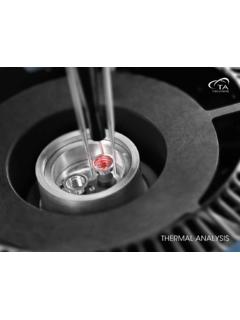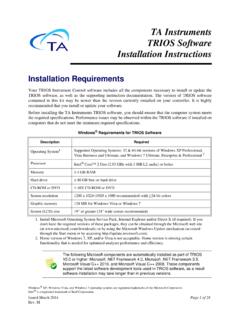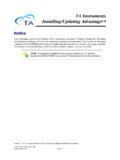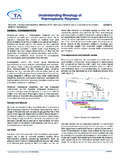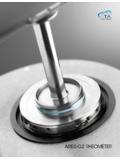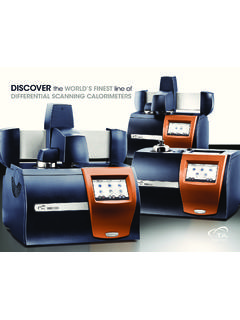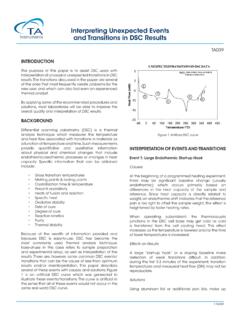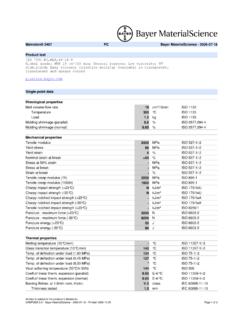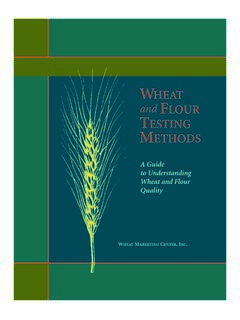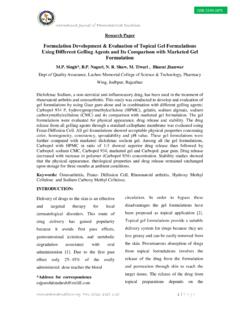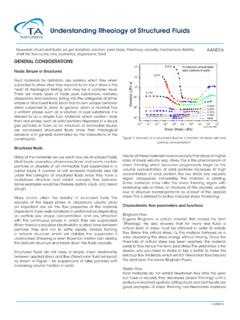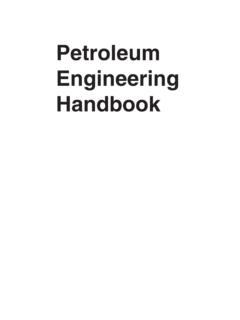Transcription of Using Rheology to Characterize Flow and Viscoelastic ...
1 Rheology to Characterize Flow and Viscoelastic properties of Hydrogels, Adhesives and BiopolymersTianhong Terri Chen PhDSenior Applications ScientistTA Instruments Waters Basics in Rheology Theory TA Instruments Rheometers and DMAs Instrumentation Test methodologies rheological Applications in Biopolymer and Biomedical Materials Hydrogels and creams Adhesives Drug capsules Polymers for medical : An : An IntroductionRheology: The study of the relationship between a stress and deformationModulusStrainStress=Viscosity rateShearStress=F = F(x); F F(v)DeformationFlowF = F(v); F F(x)Purely ElasticPurely ViscousViscoelasticDeformation + FlowSolidMost does a Rheometer do? Rheometer an instrument that measures both viscosity and viscoelasticity of fluids, semi-solids and solids It can provide information about the material s: Viscosity-defined as a material s resistance to flow deformation and is a function of shear rate or stress, with time and temperature dependence Viscoelasticity is a property of a material that exhibits both viscous and elastic character.
2 Measurements of G , G , tan with respect to time, temperature, frequency and stress/strain are important for Will Need Help with Rheology Analysis?FoodPharmaceuticalPersonal CareAdhesives & coatingPolymersAsphaltBio-medical Instruments Rheometers and DMAs TA Rotational Rheometers ARES-G2 and ARES (Strain Control SMT) DHR or AR (Stress Control CMT) TA DMAs RSA-G2 and RSA (Strain Control SMT) DMA Q800 (Stress Control CMT) Rheometers at TAControlled StrainDual HeadSMTARES G2 DHRC ontrolled StressSingle OptionsParallelPlateCone andPlateConcentricCylindersTorsionRectan gularVery Lowto Medium ViscosityVery Lowto High ViscosityVery LowViscosityto Soft SolidsSolidsWater to from TA InstrumentsControlled StrainSMTRSA G2Q800 Controlled StressCMTARES G2 and DHRDMA mode(oscillation) ClampsS/D Cantilever3-Point BendingTension-FilmTension-FiberShear-Sa ndwichCompressionSubmersibleCompressionS ubmersibleTensionSubmersible3 Pt Load FramesElectroForce 3100 (22 N)ElectroForce 5500 (200 N)
3 ElectroForce 3200 (450 N)ElectroForce 3300 (3000 N)ElectroForce 3300 Floor Standing (3000 N)ElectroForce 3510 (7500 N)ElectroForce 3500 (15000 N)Frequency to 300 HzForces to 15kNInterchangeable rheological Experimental Experiments What flow measuresoViscosity lack of slipperiness, resistance to flow The viscosity of water at room temperature is 1cP Type of flow measurements on rheometeroViscosity vs. time Viscosity at single shear rate/stress Time dependence (Thixotropy or Rheopexy)oViscosity vs. shear stress or rate Newtonian Shear thinning, shear thickening, Yield stressoViscosity vs. from a Flow Curve11) Sedimentation2) Leveling, Sagging3) Draining under rate (1/s) shear rate?8) Spraying and brushing9) Rubbing10) Milling pigments 11) High Speed coating4) Chewing, swallowing5) Dip coating6) Mixing, stirring7) Pipe stress applied sinusoidallyUser-defined Stress or Strain amplitude and frequencyPhase angle Strain, Stress, *Dynamic Oscillatory ParametersThe Elastic (Storage) Modulus: Measure of elasticity of material.
4 The ability of the material to store Viscous (loss) Modulus:The ability of the material to dissipate energy. Energy lost as Modulus: Measure of materials overall resistance to delta (phase angle):Measure of material damping - such as vibration or sound = cos G"= sin = tan = " Phase angle G*G'G"The triangle Oscillation Experiments What oscillation measures?oViscoelastic properties (G /E , G /E , tan ) Approach to Oscillation ExperimentationoStress and Strain Sweep Measure linear Viscoelastic region Yield stress, stabilityoTime Sweep Stability and structure recovery CuringoFrequency Sweep Measure polymer relaxation Compare viscoelasticity of different formulationsoTemperature Ramp Measure glass transition, Temperature operation range of a Applications in Biopolymers & Biomedical Materials main reasons for rheological testing: CharacterizationStructure-property relationship. MW, MWD, branching, state of flocculation, etc.
5 Process performanceFormulation stability, processing temperatures, extrusion, blow molding, pumping, leveling, etc. End product propertiesMechanical strength, glass transition and sub-ambient transition temperatures, dimensional stability, settling stability, of a rheological and Creams Hydrogels and creams are soft matters that contain high level of liquids such as water or oil Hydrogels and creams are used in a wide variety of applications including tissue engineering, wound patch, drug delivery, contact lenses and superabsorbent materials Rheology can provide key information on gel formation and gel strength on different Polymer: Hyaluronic Acid Hyaluronic acid is a natural polysaccharide, which is commonly used in pharmaceutical, biomedical and personal care Rheology can evaluate the visco-elastic properties as function of concentration, ionic strength, Mw, degree of crosslinking, formulations Acid Gels.
6 Hyaluronic acid gels are used as lubricating agent during abdominal surgeries to prevent adhesion and also for join lubrication, wound healing etc. Rheology can monitor HA gelation and evaluate the gel : Gelatin Gelation vs. Temperature Thermal reversible gelatin gels:oMeasure gelation and gel Gel Strength at Different Concentration A dynamic frequency sweep test can be used to compare gel strength at applications Conjugation Use enzymatic approach to covalently graft gelatin to chitosan The conjugate exhibits interesting mechanical properties Applications as biomedical adhesivesChen et al. Biopolymers, Vol. 64, 292-302 (2002) GelsChen T; Raghavan SR et al, Langmuir, 21, 26-33 (2005) Attach n-dodecyl tails to Chitosan backbone to obtain an associating biopolymer (HM-Chitosan) HM-Chitosan mixed with surfactant vesicle solution leads to a gel formation This hydrogel showed strong elasticity behavior and has potential applications in biomedical control Lens frequency (rad/s) (delta)Vendor AVendor B Compare frequency dependency of contact lens elasticityt!
7 "# =$"$% : Stability Testing'''''''''''lllllllllllppppppppppp lllllllllll012345678910strain [%]1E+031E+041E+051E+06 Moduli G' & G'' [Pa]G' emulsion AG'' emulsion AG' emulsion BG'' emulsion BlplpStability, phase separation of a cosmetic Temperature Performance of Lotions010203040506010010110210302 hydrating beauty lotion same lotion with UV protection generic hydrating lotionModulus G' [Pa]Temperature T [ C] Loss tan G for A decreases at 37oC G for B withstands higher temperature =>used at higher temperature conditions (beach) G for lotion C increases before dropping; tan decreases => phase separation for lotion C Tan for A & B increases above 37oC=> wax crystals melt and lower the modulus Ming L. Yao; Jayesh C. Patel Appl. Rheol. 11,2,83 (2001)A: Hydrating Lotion B: UV Protection C: Generic Temperature Performance of Lotions-30-20-100102030103104105106o/w emulsion: G' G"-8oCModulus G' [Pa]Temperature T [oC]-100 -80 -60 -40 -20020406080 emulsion G' G"Modulus G', G" [Pa]Temperature T [oC] tand tan In an o/w emulsion the freezing point of water is depressed due to the dispersed oil phase.
8 Cooling below the freezing point has a major effect on temperature stability In an w/o emulsion, the dispersed water droplets freeze, but not the matrix. These emulsions do not have a sharp freezing Rheology essentials of Cosmetics Springer ISBN: 3-540-25553-2 Modulus G , G [Pa] Temperature StabilityV. Andr , N. Willenbacher, H. Debus, L. B rger, P. Fernandez, T. Frechen, J. Rieger. Prediction of Emulsion Stability: Facts and Myth . Cosmetics and Toiletries Manufacture Worldwide Cycle temperature to evaluate temperature stability of : Coefficient of Friction37 C, 3 N loadTransporeApplication Adhesives35 Adhesives are used in biomedical device assembly; hard tissue or soft tissue attachments ( dentistry or wound closure) Rheology helps to guide adhesive process Rheology measurements can correlate to the tack and peel performance of the finial Test Tack TestingCrosslinked PSA:Adhesive failureNon-Crosslinked PSA:Cohesive failure Experimental: 8mm parallel plate, Axial tensile at 180 Degree Peel The SER geometry on a rheometer can perform peel test at 180 degree Temperature Ramp Glass transition: Tg = C G crossover: Tx = C Dahlquist temperature: Td = C Plateau modulus G p = 7694 Pa Most popular test in adhesive industry The measurement results correlate to the performance of a PSA with.
9 Tack and Peel Performance A dynamic frequency sweep test results can correlates to tack and peel and Peel performance of a PSApeeltack good tack and peel Bad tack and peel Storage Modulus G' [Pa]Frequency [rad/s] Adhesive UV (s) |G *| (Pa)Formulation #1 Formulation #2 Formulation #3 Formulation #4 Formulation #5 Dental materials cure under blue Curing Shrinkage Adhesive curing shrinkage will cause fractures in process Using rheometer + UV curing accessory, we can quantitatively monitor the shrinking force during curing or the dimension shrinkageMonitor force buildupMonitor dimension/gap Capsules Drug capsules are typically made from gelatin or polysaccharide such as (HPMC) Rheology and DMA can help to investigate the optimum capsule process conditions and also evaluate the capsule properties with a controlled temperature and Capsule: Mechanical Strength vs. Temperature and Humidity100200300400 Loss Modulus (MPa)020406080100 Relative Humidity (%)010002000300040005000 Storage Modulus (MPa)30405060708090 Time (min) T25C-RAMP T37C-RAMP T50C-RAMP Universal TA Instruments A dynamic temperature or humidity ramp experiment can help evaluate the mechanical properties (stability) of gelatin capsules at different storage conditions (temperature and humidity).
10 25 C50 C37 Soluble Cellulose - HPMC Hydroxypropyl methylcellulose (HPMC) Soluble in cold water, insoluble in hot water. Gelation temperature and gel strength depending on the ratio of HP/MC and degree of substitution Cellulose based drug Gelation ( C) ' (P a) '' (P a )HPMC Temp RampGelation T = CG': Pa Thermal reversible gel Transition from intra-molecular interaction to inter-molecular interactionCapsule manufacturing process a hot pin dipped into a cold Medical Devices47 Polymers are used as medical devices such as hips and knees joints, sutures, stents, and facial prostheses etc. ApplicationPolymer UsedKnee, Hip, & Shoulder JointsUltrahigh molecular weight polyethylene (UHMWPE)Finger JointsSiliconeSuturesPolylactic and Polyglycolic acid, NylonTracheal TubesSilicone, Acrylic, NylonHeart PacemakerAcetal, Polyethylene, PolyurethaneBlood VesselsPolyester, PVC, Polytetrafluoroethylene, Gastrointestinal SegmentsNylon, PVC, SiliconesFacial ProsthesesPolydimethyl siloxane, Polyurethane, PVCBone CementPolymethyl methacrylate Rheology helps to guide process conditions and evaluate end product Acid (PLA) Polylactic acid (PLA) and its composite materials are FDA approved synthetic degradable polymers.
